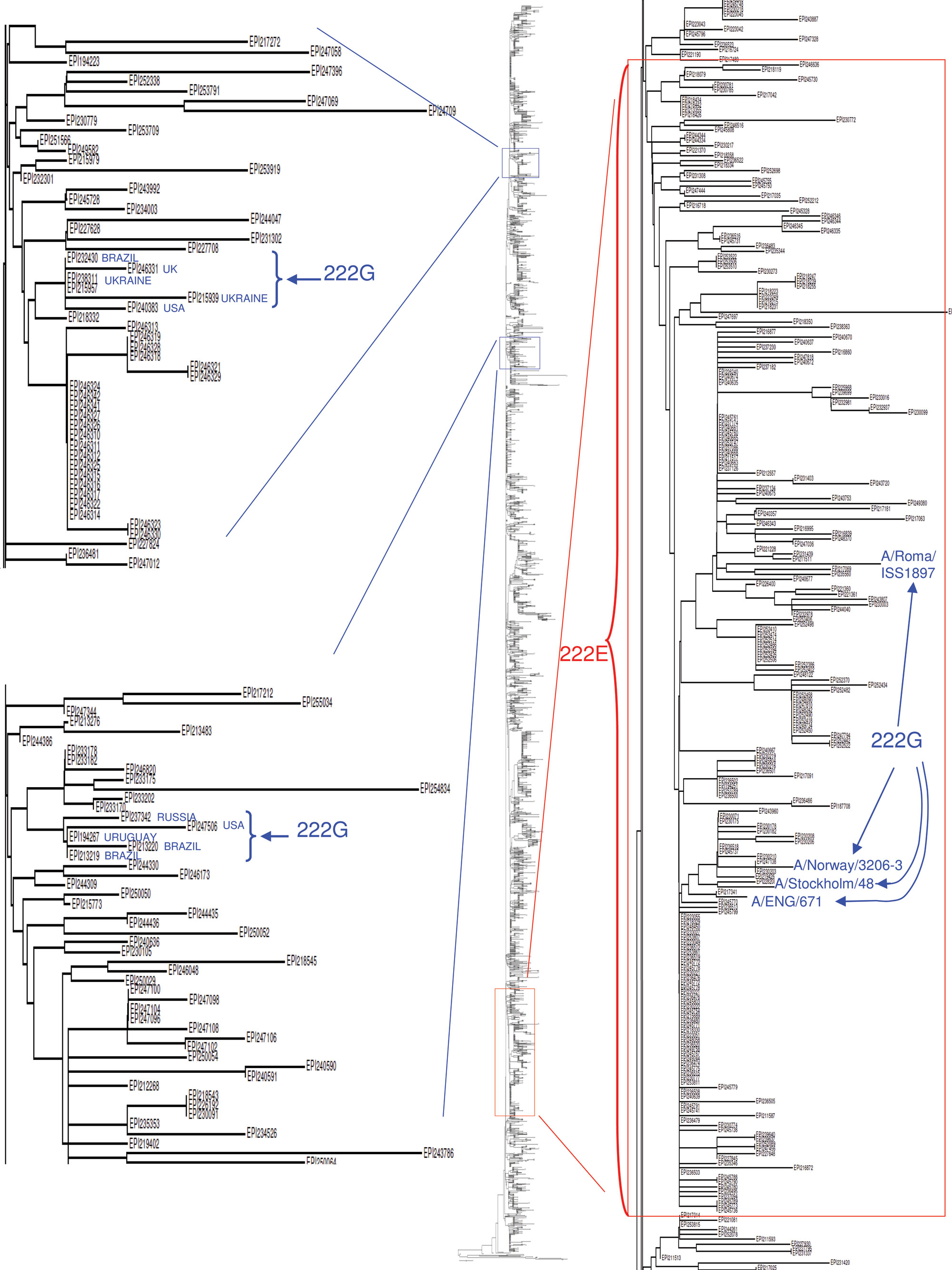Volume 17, Number 4—April 2011
Letter
Hemagglutinin 222 Variants in Pandemic (H1N1) 2009 Virus
Figure

Figure. Phylogenetic relationships among 2,492 complete hemagglutinin (HA) genes of pandemic (H1N1) 2009. At the center, the whole neighbor-joining tree. On the left, enlargement of 2 regions of the tree including pure monophyletic D222G clusters, indicated in blue. On the right, enlargement of the monophyletic D222E virus cluster, including 98% of the global 222E isolates (red box). E222G variant isolates, as examples, respectively, from Italy (4), Norway (1), Sweden, and the United Kingdom, are indicated in blue. The sequence labels represent the Global Initiative on Sharing All Influenza Data serial numbers; those of particular interest for this study are indicated by the strain name or country of origin.
References
- Kilander A, Rykkvin R, Dudman SG, Hungnes O. Observed association between the HA1 mutation D222G in the 2009 pandemic influenza A(H1N1) virus and severe clinical outcome, Norway 2009–2010. Euro Surveill. 2010;15:pii:19546.
- Mak GC, Au KW, Tai LS, Chuang KC, Cheng KC, Shiu TC, Association of D222G substitution in haemagglutinin of 2009 pandemic influenza A (H1N1) with severe disease. Euro Surveill. 2010;15:pii:19498.
- Miller RR, MacLean AR, Gunson RN, Carma WF. Occurrence of haemagglutinin mutation D222G in pandemic influenza A(H1N1) infected patients in the west of Scotland, United Kingdom, 2009–10. Euro Surveill. 2010;15:pii:19498.
- Puzelli S, Facchini M, Spagnolo D, De Marco MA, Calzoletti L, Zanetti A, Transmission of hemagglutinin D222G mutant strain of pandemic (H1N1) 2009 virus. Emerg Infect Dis. 2010;16:863–5.PubMedGoogle Scholar
- Valli MB, Meschi S, Selleri M, Zaccaro P, Ippolito G, Capobianchi MR, Evolutionary pattern of pandemic influenza (H1N1) 2009 virus in the late phases of the 2009 pandemic. PLoS Curr. 2010;2:RRN1149. DOIPubMedGoogle Scholar
- Nelson M, Spiro D, Wentworth D, Beck E, Fan J, Ghedin E, The early diversification of influenza A/H1N1pdm. PLoS Curr. 2009;1:RRN1126. DOIPubMedGoogle Scholar
- Fereidouni SR, Beer M, Vahlenkamp T, Starick E. Differentiation of two distinct clusters among currently circulating influenza A(H1N1)v viruses, March–September 2009. Euro Surveill. 2009;14;pii:19409. PMID 19941799
Page created: July 25, 2011
Page updated: July 25, 2011
Page reviewed: July 25, 2011
The conclusions, findings, and opinions expressed by authors contributing to this journal do not necessarily reflect the official position of the U.S. Department of Health and Human Services, the Public Health Service, the Centers for Disease Control and Prevention, or the authors' affiliated institutions. Use of trade names is for identification only and does not imply endorsement by any of the groups named above.